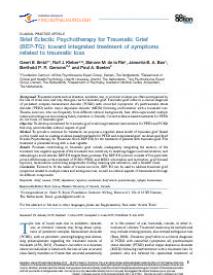Brief Eclectic Psychotherapy for Traumatic Grief (BEP-TG): toward integrated treatment of symptoms related to traumatic loss
Background: Traumatic events such as disasters, accidents, war, or criminal violence are often accompanied by the loss of loved ones, and may then give rise to traumatic grief. Traumatic grief refers to a clinical diagnosis of persistent complex bereavement disorder (PCBD) with comorbid (symptoms of) posttraumatic stress disorder (PTSD) and/or major depressive disorder (MDD) following confrontation with a traumatic loss. Trauma survivors, who are frequently from different cultural backgrounds, have often experienced multiple losses and ambiguous loss (missing family members or friends). Current evidence-based treatments for PTSD do not focus on traumatic grief.
Objective: To develop a treatment for traumatic grief combining treatment interventions for PTSD and PCBD that may accommodate cultural aspects of grief.
Method: To provide a rationale for treatment, we propose a cognitive stress model of traumatic grief. Based on this model and on existing evidence-based treatments for PTSD and complicated grief, we developed Brief Eclectic Psychotherapy for Traumatic Grief (BEP-TG) for the treatment of patients with traumatic grief. The treatment is presented along with a case vignette.
Results: Processes contributing to traumatic grief include inadequately integrating the memory of the traumatic loss, negative appraisal of the traumatic loss, sensitivity to matching triggers and new stressors, and attempting to avoid distress. BEP-TG targets these processes. The BEP-TG protocol consists of five parts with proven effectiveness in the treatment of PCBD, PTSD, and MDD: information and motivation, grief-focused exposure, memorabilia and writing assignments, finding meaning and activation, and a farewell ritual.
Conclusion: Tailored to fit the needs of trauma survivors, BEP-TG can be used to address traumatic grief symptoms related to multiple losses and ambiguous loss, as well as cultural aspects of bereavement through its different components.
Geachte bezoeker,
De informatie die u nu opvraagt, kan door psychotraumanet niet aan u worden getoond. Dit kan verschillende redenen hebben,
waarvan (bescherming van het) auteursrecht de meeste voorkomende is. Wanneer het mogelijk is om u door te verwijzen naar de bron
van deze informatie, dan ziet u hier onder een link naar die plek.
Als er geen link staat, kunt u contact opnemen met de bibliotheek,
die u verder op weg kan helpen.
Met vriendelijke groet,
Het psychotraumanet-team.
Reference:
Geert E. Smid, Rolf J. Kleber, Simone M. de la Rie, Jannetta B. A. Bos, Berthold P. R. Gersons, Paul A. Boelen | 2015
In: European Journal of Psychotraumatology, ISSN 2000-8066 | 6 | 1-11
http://www.ejpt.net/index.php/ejpt/article/view/27324
In: European Journal of Psychotraumatology, ISSN 2000-8066 | 6 | 1-11
http://www.ejpt.net/index.php/ejpt/article/view/27324


